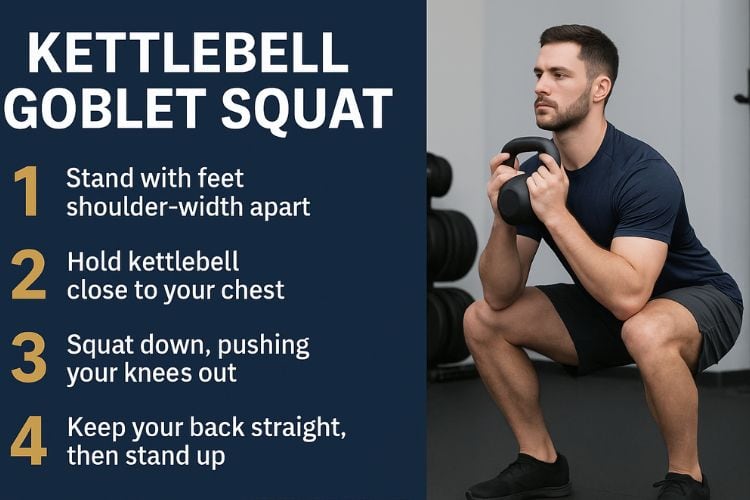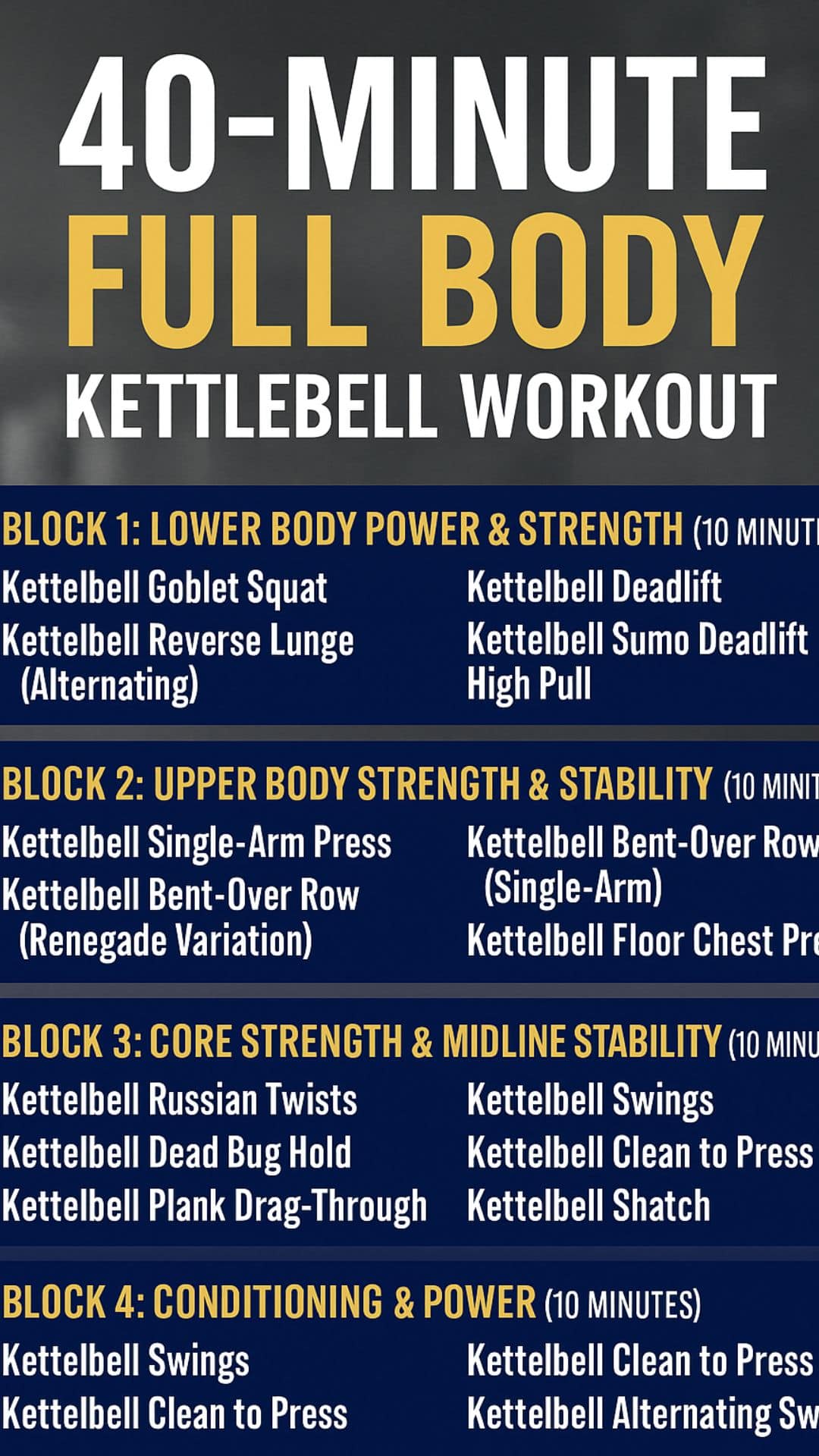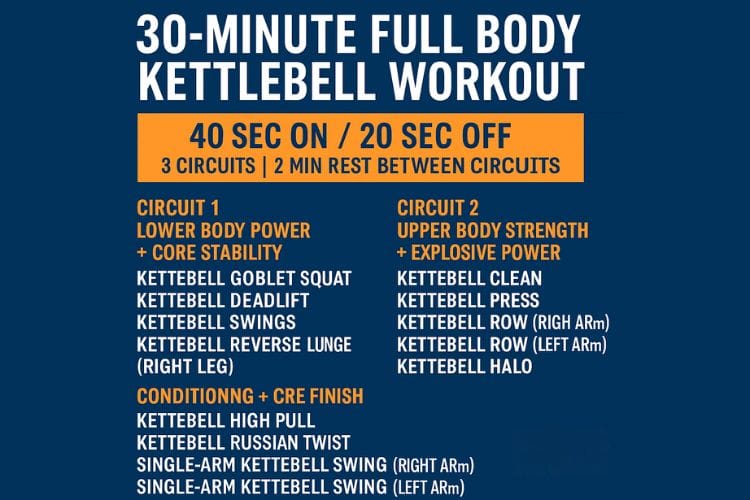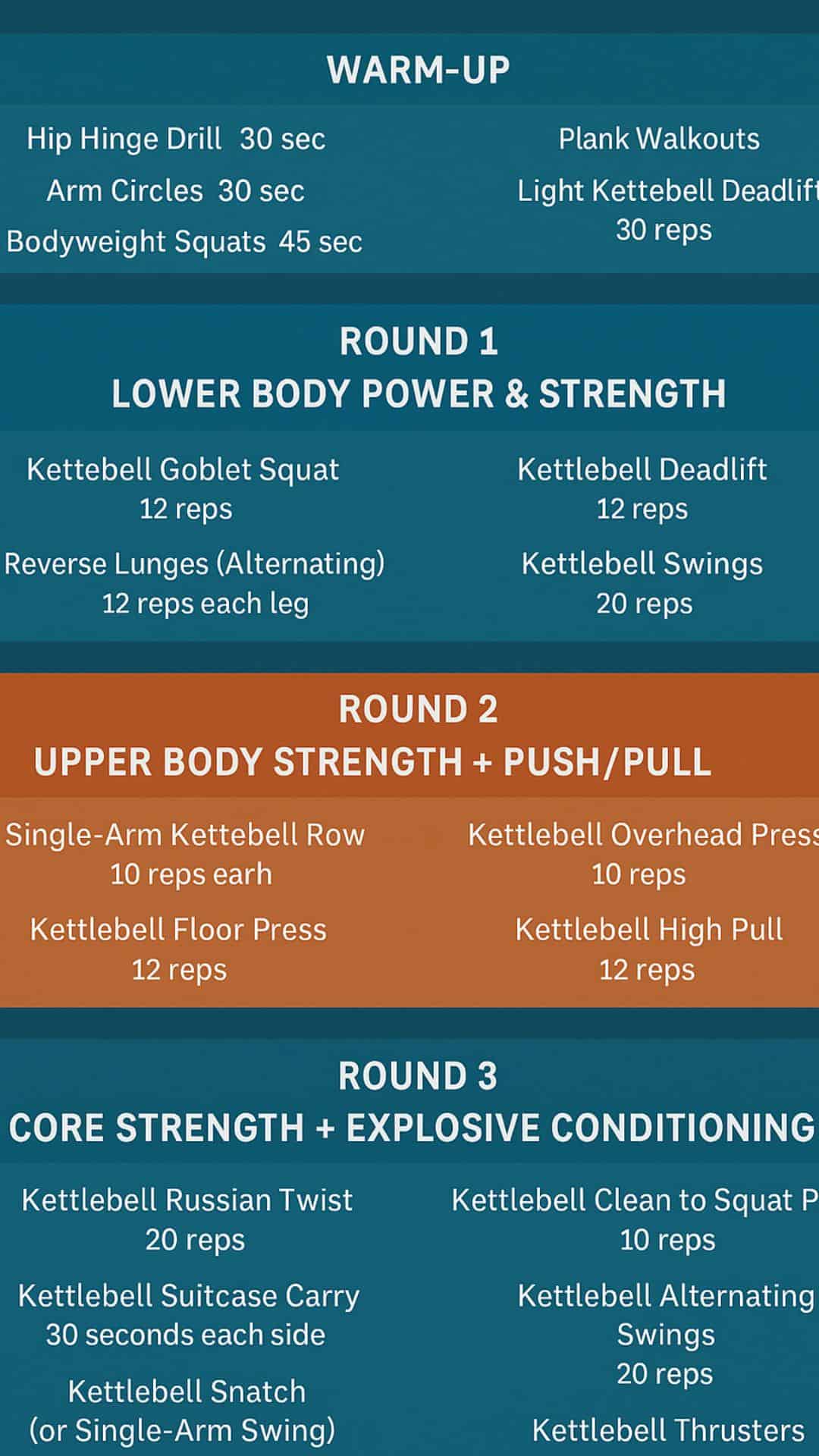
45 Minutes to Fit: A Full-Body Kettlebell Workout for All Levels

40-Minute Full-Body Kettlebell Workout (Build Muscle, Burn Fat)

30-Minute Kettlebell Workout for Total-Body Strength

25-Minute Full Body Kettlebell Workout for Strength & Fat Loss
Fitness Myths Debunked That You Believe

Fitness is an arena filled with numerous myths and misconceptions, often leading to confusion and ineffective practices. This blog aims to debunk 36 of the most common fitness myths, using scientific evidence and expert opinion to guide you towards a more effective and informed fitness journey.
1. Fitness Myths Lifting Weights Makes Women Bulky
Reality: Weight lifting for women leads to toned muscles and improved strength without necessarily adding bulk. It’s a myth that lifting weights will automatically make women look bulky.
2. Myth: You Can Spot Reduce Fat
Reality: It’s impossible to target fat loss in specific body parts. Fat loss occurs evenly across the body depending on genetics, diet, and overall exercise.
3. Myth: No Pain, No Gain
Reality: While exercise can be challenging, pain is not a sign of effectiveness. Persistent pain can be a sign of injury and should not be ignored.
4. Myth: You Need to Sweat for a Workout to be Effective
Reality: Sweat is not an indicator of how effective your workout is. It’s simply your body’s way of regulating temperature.
5. Fitness Myths: Cardio is the Best Way to Lose Weight
Reality: While cardio is important, a combination of strength training and cardio is more effective for long-term weight loss and fitness.
6. Myth: Exercise on an Empty Stomach Burns More Fat
Reality: Exercising on an empty stomach can lead to muscle loss and decreased performance. A balanced meal before exercise is essential.
7. Myth: More Gym Time Always Equals Better Results
Reality: Quality trumps quantity. Overtraining can lead to injury and burnout. It’s important to have a balanced and structured workout plan that can help to shrink your stomach.
8. Myth: Muscle Turns into Fat When You Stop Exercising
Reality: Muscle and fat are two different tissues. If you stop exercising, muscles shrink, and fat cells may increase if you consume more calories than you burn.
9. Fitness Myths: Stretching Before a Workout Prevents Injuries
Reality: Dynamic stretching is beneficial before workouts, not static stretching. Static stretching is better suited for cooling down.
10. Myth: You Need Supplements to Build Muscle
Reality: While supplements can aid, they are not essential. Muscle growth is primarily dependent on diet and effective training.
11. Fitness Myths: You Can Eat Whatever You Want If You Exercise
Reality: Diet plays a crucial role in fitness. Even with exercise, a poor diet can prevent you from reaching your fitness goals.
12. Myth: High-Intensity Workouts Are for Everyone
Reality: High-Intensity Interval Training (HIIT) isn’t suitable for everyone, especially beginners or individuals with certain health conditions.
13. Myth: Crunches are the Key to Flat Abs
Reality: A variety of exercises, along with proper diet, are needed for flat abs. Crunches alone are not enough.
14. Myth: The Scale is the Best Indicator of Fitness
Reality: The scale doesn’t differentiate between muscle and fat. Body composition and overall health are better fitness indicators.
15. Myth: Yoga Isn’t a Real Workout
Reality: Yoga improves flexibility, balance, core strength, and mental well-being. It’s a legitimate form of exercise.
16. Fitness Myths: You Shouldn’t Exercise Every Day
Reality: Daily exercise is beneficial, but it should vary in intensity and type to avoid overtraining and ensure recovery.
17. Myth: Weight Lifting Decreases Flexibility
Reality: Weight lifting, when done properly, can improve flexibility. It’s a misconception that it always leads to reduced flexibility.
18. Myth: Running is Bad for Your Knees
Reality: With proper form and footwear, running can strengthen the knees. However, overdoing it or running with bad form can lead to injuries.
19. Myth: Older Adults Shouldn’t Lift Weights
Reality: Weight lifting is beneficial for older adults, improving strength, balance, and bone density.
20. Myth: Fitness is All About the Gym
Reality: Fitness extends beyond the gym. Daily activities, outdoor sports, and even household chores contribute to overall fitness.
21. Myth: You Need to Work Out for Hours for It to Be Effective
Reality: Quality matters more than quantity in fitness. Short, focused sessions can be as effective, if not more, than longer, less intensive workouts. High-intensity interval training (HIIT), for example, offers significant benefits in a shorter timeframe.
22. Fitness Myths: If You’re Not Sore After a Workout, It Wasn’t Effective
Reality: Soreness, or Delayed Onset Muscle Soreness (DOMS), isn’t a reliable indicator of the effectiveness of a workout. Consistent progress over time is a better measure of fitness gains.
23. Myth: Machines Are Safer and Better Than Free Weights
Reality: Both machines and free weights have their place in a fitness regimen. Free weights can offer a more holistic workout by engaging more muscle groups for stabilization.
24. Fitness Myths: Eating Fat Makes You Fat
Reality: Dietary fats are essential for the body. The key is consuming the right types of fat in moderation, like those found in avocados, nuts, and fish.
25. Myth: You Can’t Work Out When You’re Older
Reality: Exercise is crucial at any age and can be adapted to individual capabilities and health conditions. It improves strength, flexibility, balance, and mental health in older adults.
26. Fitness Myths: All Calories Are Equal
Reality: The type of calories consumed matters as much as the amount. 500 calories from fruits and vegetables have a different impact on your body than 500 calories from processed foods.
27. Myth: Rest Days Are for the Weak
Reality: Rest days are essential for muscle recovery and growth. They prevent overtraining and reduce the risk of injury.
28. Myth: If You’re Not Losing Weight, Your Workout Isn’t Working
Reality: Weight loss is not the sole indicator of fitness. Muscle gain, improved endurance, and better overall health are also important outcomes of regular exercise.
29. Fitness Myths: You Should Always Work Out at the Same Time
Reality: While consistency is key, the best time to work out is when it fits into your schedule. The important thing is to maintain a regular routine.
30. Myth: More Protein Always Equals More Muscle
Reality: While protein is essential for muscle repair and growth, excessive protein intake without a balanced diet and proper training won’t result in added muscle gain.
31. Myth: You Need a Gym Membership to Get Fit
Reality: Fitness can be achieved anywhere. Bodyweight exercises, outdoor activities, and improvised home workouts can be highly effective.
32. Fitness Myths: Sports Drinks Are the Best Way to Rehydrate
Reality: For most people, water is sufficient for hydration. Sports drinks are only necessary for prolonged, intense physical activity.
33. Myth: You Need to Do Cardio to Lose Weight
Reality: Weight loss is about creating a calorie deficit, which can be achieved through diet, strength training, cardio, or a combination of these.
34. Myth: Static Stretching is the Best Warm-up
Reality: Dynamic stretching is more effective as a warm-up to prepare the muscles and joints for physical activity.
35. Fitness Myths: The Best Time to Work Out is in the Morning
Reality: The best time for a workout is when you can consistently fit it into your schedule, whether that’s morning, noon, or night.
36. Myth: You Should Drink Water Only When Thirsty During Exercise
Reality: Staying hydrated is crucial, especially during exercise. Don’t wait until you’re thirsty to drink water.
Busting these 36 fitness myths empowers you with the knowledge to approach your fitness journey with more confidence and clarity. Remember, individual needs vary, and what works for one person may not for another. Listen to your body, stay informed, and consult fitness and health professionals when in doubt. Here’s to your health and fitness success!
Most Recommended
Subscribe to our Newsletter
Stay up to date on the latest men’s health, fitness and lifestyle trends and tips.
About Us
Men’s Fit Club was started with the goal of empowering men to get the most out of their lives. This meant going beyond exercise and diet tips to really address the broad range of issues that men face on a daily basis – topics like recreation, finding love, sexual health and even sound fashion advice.
Quick Links
© COPYRIGHT MEN'S FIT CLUB 2025. All Rights Reserved

